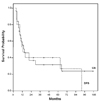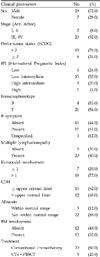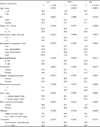1. Picozzi VJ Jr, Coleman CN. Lymphoblastic lymphoma. Semin Oncol. 1990. 17:96–103.
2. Coleman CN, Picozzi VJ Jr, Cox RS, McWhirter K, Weiss LM, Cohen JR, et al. Treatment of lymphoblastic lymphoma in adults. J Clin Oncol. 1986. 4:1628–1637.
3. Thomas DA, O'Brien S, Cortes J, Giles FJ, Fanderl S, Verstovsek S, et al. Outcome with the hyper-CVAD regimens in lymphoblastic lymphoma. Blood. 2004. 104:1624–1630.
4. Sweetham JW, Santini G, Qian W, Guelfi M, Schmitz N, Simnett S, et al. High-dose therapy and autologous stem-cell transplantation versus conventional-dose consolidation/ maintenance therapy as postremission therapy for adult patients with lymphoblastic lymphoma: results of a randomized trial of the European Group for Blood and Marrow Transplantation and the United Kingdom Lymphoma Group. J Clin Oncol. 2001. 19:2927–2936.
5. Carbone PP, Kaplan HS, Musshoff K, Smithers DW, Tubiana M. Report of the Committee on Hodgkin's Disease Staging Classification. Cancer Res. 1971. 31:1860–1861.
6. Hahn JS, Lee S, Chong SY, Min YH, Ko YW. Eight-year experience of malignant lymphoma-survival and prognostic factors. Yonsei Med J. 1997. 38:270–284.
7. Hahn JS, Kim YS, Lee YC, Yang WI, Lee SY, Suh CO. Eleven-year experience of low grade lymphoma in Korea (Based on REAL classification). Yonsei Med J. 2003. 44:757–770.
8. Chen YC, Ho CL, Kao WY, Hwang JM, Sheu LF, Chao TY. Adult lymphoblastic lymphoma in Taiwan: an analysis of treatment results of 26 patients. Ann Hematol. 2001. 80:647–652.
9. Levine JE, Harris RE, Loberiza FR Jr, Armitage JO, Vose JM, Van Besien K, et al. A comparison of allogeneic and autologous bone marrow transplantation for lymphoblastic lymphoma. Blood. 2003. 101:2476–2482.
10. Kim DW, Sun JM, Kwon JH, Oh DY, Lee JJ, Jo YH, et al. An analysis of treatment results of lymphoblastic lymphoma in adults according to the chemotherapy regimens. Korean J Hematol. 2003. 38:32–39.
11. Oh SJ, Kim SB, Suh CW, Ahn JH, Kim WK, Lee JS. Feasibility of autologous stem cell transplantation in 12 patients with adult lymphoblastic lymphoma; Experience of Single Institution (Abstract). 2002. In : The 28th Annual Meeting of The Korean Cancer Association;
12. Le Gouill S, Lepretre S, Briere J, Morel P, Bouabdallah R, Raffoux E, et al. Adult lymphoblastic lymphoma: a retrospective analysis of 92 patients under 61 years included in the LNH87/93 trials. Leukemia. 2003. 17:2220–2224.
13. Smith SM, Grinblatt D, van Besien K. Autologous and allogeneic transplantation for aggressive NHL. Cytotherapy. 2002. 4:223–240.
14. Bierman PJ. Allogeneic bone marrow transplantation for lymphoma. Blood Rev. 2000. 14:1–13.
15. Lee KH. Allogeneic HCT for lymphoma. Korean J Hematol. 2005. 40:Suppl 1. S22.
16. Hahn JS, Cho JY, Lee ST, Chung SY, Min YH, Ko YW. Therapeutic outcome and prognosis in elderly patients with non-Hodgkin's lymphoma. J Korean Cancer Assoc. 1999. 31:320–330.








 PDF
PDF ePub
ePub Citation
Citation Print
Print







 XML Download
XML Download